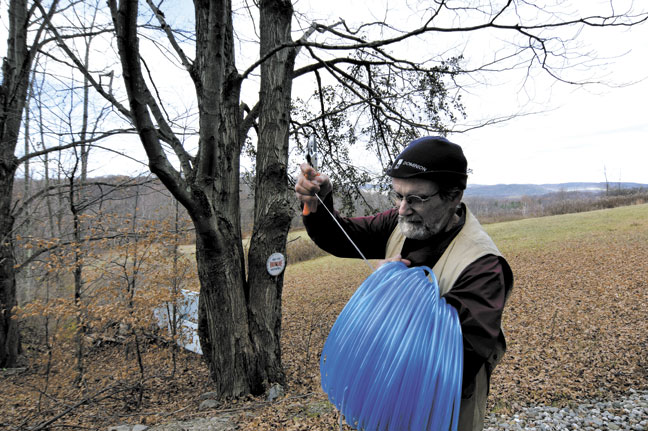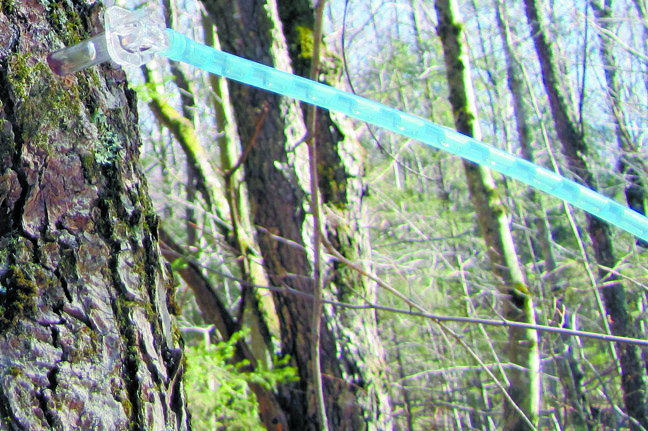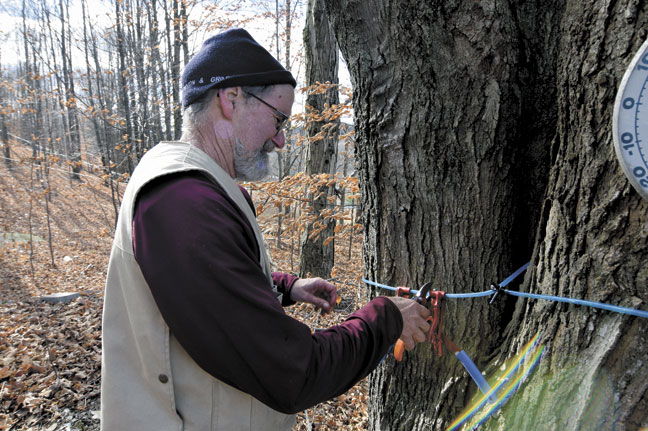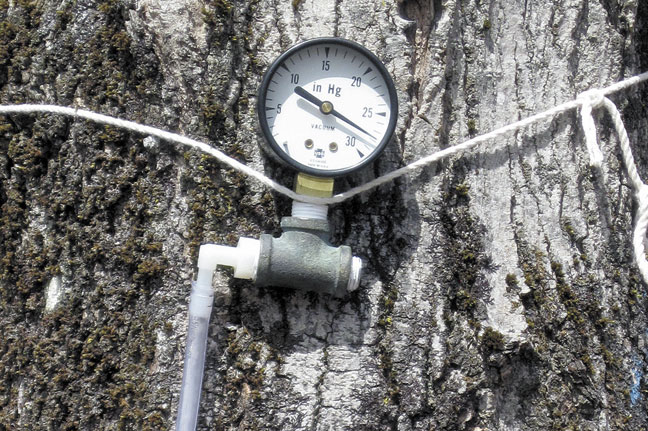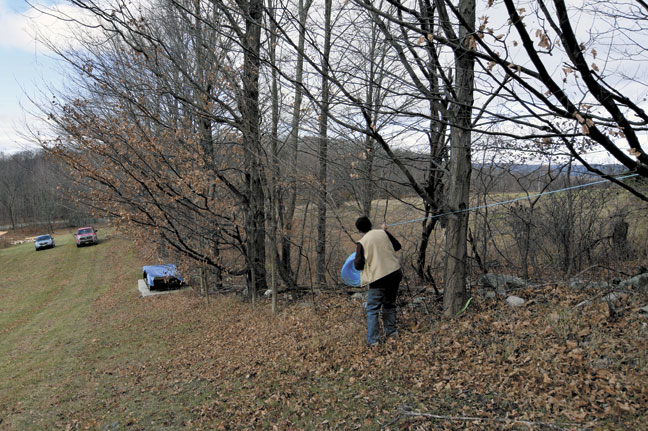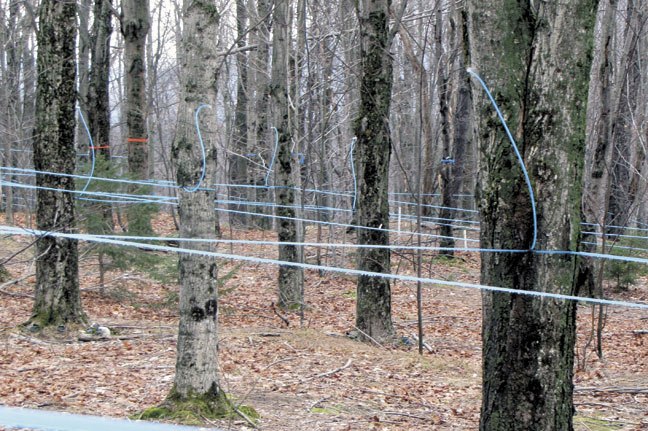Tapping & Tubing
3/16ths guru Tim Wilmot. The gravity of it all.
Using 3/16th-inch tubing for gravity sap collection
By TIM WILMOT, UNIVERSITY OF VERMONT EXT. MAPLE SPECIALIST (RETIRED) RESEARCHER FOR DOMINION AND GRIMM INC. | JAN. 13, 2018
The use of 3/16” tubing for sap collection began as a series of experiments that I conducted while working at the University of Vermont Proctor Maple Research Center. The goal was to devise a gravity sap collection method that would improve production for sugarmakers with small operations who typically collected much less sap than producers using vacuum pumps. Over the past 8 years I have continued to conduct research with this tubing in an effort to learn more about its potential uses and possible shortcomings, both for gravity and pumped sap collection. This first article summarizes findings related to gravity or “natural” vacuum; a second article will cover the use of 3/16” tubing with vacuum pumps. All of the results described here come from my own research, unless otherwise noted.
Two previous published articles explain much of my earlier findings with 3/16” tubing, and can be found online by visiting the homepage of the Proctor Maple Research Center website and opening “High Vacuum in Gravity Tubing” and “3/16 Tubing.” Sugarmakers unfamiliar with 3/16” tubing are urged to read these articles.
The physics of producing natural vacuum:
Vacuum can be produced at the top of a closed tube that is full of liquid and open at the bottom. The strength of the vacuum comes from the weight of the sap, and the weight is determined by the vertical height of the sap column, not by the total amount of sap in the tube. Thus, in a small diameter tube (3/16” for example) a given amount of sap will form a longer column than in a larger diameter tube (5/16”). On a slope, the longer column of sap extends over a greater height, creating greater weight and more vacuum at the top (where there is a connection to a taphole). Any tube with a smaller interior diameter than 5/16” will produce a longer sap column—but 3/16,” which has been the subject of this research, is a practical alternative to 5/16” because it is significantly smaller, yet the tubing and fittings are still strong enough to hold up in the woods.
The principles of a vacuum in a gravity sap line
An example demonstrates many of the principles of a 3/16” gravity tubing system. In 2015 and 2016 a single 400’ line was placed running downhill to a tank. The line dropped 62’ vertically from the uppermost tree to the tank, with a slope of 62’/400’ or about 16%. Twenty five taps were spread out along this line, and at certain elevations I placed vacuum gauges at the trees: at 62’ above the tank, 53’, 39’, 25’ and 11’ above the tank. During the spring of both years, whenever the trees were thawed and the sap was flowing, the vacuum reading at each individual gauge was approximately the same: 28” Hg at the 62’ elevation above the tank, 27” at 53’ elevation, 24.5” at 39’ elevation’, 19” at 25’ elevation, and 11” Hg at 10’ elevation above the tank.
The example shows several principles of a well-functioning gravity line:
1. The vacuum at each tree is a function of the height above the tank.
2. Once the sap is flowing well, the vacuum at each point should be about the same every day (at the top it should always be about 28” in this case).
3. The vacuum in the line is typically less than theoretical maximum (1 vertical foot of sap = 0.88” of vacuum). For example, at 39’ the maximum of 28” should have been achieved but it was not.
4. The length of the line is not important for achieving vacuum.
5. Below a certain point along the line, there is not enough height above the tank for the tapholes to achieve the maximum possible vacuum. In this case, only about 5 of the 25 trees achieved the maximum vacuum (28”).
6. Closer to the tank, the height is not enough to provide more than minimal vacuum (10” or less for about 4 trees).
7. The only way to increase the vacuum for all the trees below the uppermost 5 would be to move the tank farther down the slope.
Note that the word “tank” refers to the bottom of the line, where the 3/16” and the vacuum it produces ends. It could also end at a mainline; in that case again the vacuum would end where the 3/16” ends, assuming that the mainline is not connected to a pump. In an all gravity setup, the mainline serves as a trough to carry sap to the tank and should be pitched at a minimal angle to do so.
Slope needed for gravity collection
Total height, the vertical distance from the tree to the bottom of the line, is much more important than slope. Some of the best results (see previous articles) came from experiments done at the Proctor Center on a hillside that had a long, very gently sloping plateau where most of the trees were tapped. Beyond the plateau was a steep ravine, and I placed my tanks at the bottom, over 700’ from the top of the line. The total descent from most of the plateau to the tanks was 50-75’, so that most trees were that height above the tank, and therefore high vacuum could be achieved at these tapholes. The slope to the ravine was about 30% -40%, which was the maximum slope in any of my experiments. The only difference noted using a steep slope compared to a shallower slope was the greater speed of the sap on the steeper slope. In general, sap speed is determined both by the slope, and the amount of sap in the tube—thus it is usually much faster at the bottom of the slope than near the top.
For a line with a uniform slope with trees all along the slope, as described in the first example, many trees close to the tank will have less than ideal vacuum. I have not experimented with lines where the entire height difference between the top of the line and the tank was less than about 10 feet. There may be a minimal height difference that is required for steady flow, especially on low sap flow days. While there is some debate about what constitutes “flat” land, 3/16” tubing was never intended for use on land with no real descent from the tree to the tank, and its advantages are likely to be outweighed by its disadvantages in such conditions.
Line length and number of taps on a gravity line
For many producers using gravity tubing in a relatively small woodlot, the number of taps on a line may be limited by the length of the slope and the density of the maples. A 3/16” line with only one tap will produce high vacuum at the taphole if there is adequate height above the tank (I heard Glen Goodrich mention this in 2016 and found in my own trials that I could get the same vacuum with one tap compared to lines with multiple taps). In some experiments, lines with 4-6 taps, 75-200’ long, were used on steep and/or shallow (10-12%) slopes. Vacuum and sap production were related to height above the tank in all cases—the steepness of the slope did not produce unexpected results. Lines can be made quite crooked in order to increase the number of taps on a line (for a more efficient use of materials) and tests with these crooked lines have shown no real decrease in vacuum or production caused by friction loss. Lines with many taps (30+) can also work very well, as described in a previous article, and in a 2013 experiment a line with 37 taps performed as well as lines with 6-8 taps. The main drawback to lines with many taps is the need for diligent leak-checking, which can be more difficult on a very long line with many taps, and is most critical, as a leak can cause the loss of all vacuum on the line. This would be much more serious for overall production when it occurred on a line with 50 taps vs. a line with 15 taps.
The minimum number of taps needed to make a 5/16” line produce high vacuum is probably 20. Many comparisons of 3/16” with 5/16” lines, described in the earlier articles, showed that at best, a 5/16” line with 30 taps could produce about 90% as much sap as a similar 3/16” line. Usually the 5/16” lines fared much worse than this, as the highest vacuum in these lines was present only during periods of heavy sap flow, while in 3/16” tubing high vacuum persisted to near the end of the season.
Using gravity vacuum to lift sap
There are several reasons why a producer would want to use vacuum to lift sap against gravity, including giving a line vertical clearance to cross a road, pulling sap up from trees in a hollow or on a back slope, or pulling sap up the droplines when tapping below the lateral line. In all cases, the vacuum to do this work must be generated using a column of sap moving down a slope, as described in examples above. An inch of vacuum can lift sap over 1.1 feet vertically, so in theory, 26” of vacuum should be able to lift sap 29’. Therefore a road crossing, where the tubing must jump over a road and then continue down a hill, can be successfully managed as long as the vacuum just beyond the road is strong enough to lift sap higher than the crossing. I have successfully used road crossings where the lateral line was lifted between 5 and 13 feet and then brought down on the other side, where it continued down a slope. Using 3/16” tubing, there appeared to be no reduction in flow at any time as the sap climbed over the road.
Lifting sap from the back slope of a hill and then down a front slope is also easily done if the vacuum at the top of the hill is strong enough to pull the sap over the top. In theory it should be possible to calculate how much vacuum is lost in lifting the sap—for example if the vacuum at the top of the hill is 26” and the line on the back slope descends 12’, the vacuum at the lowest trees on the back slope should be about 17”; however, its best to have a margin of error in counting on the vacuum to do the work. As with the road crossings, I have found that the theory doesn’t always match what is happening.
Sap can also be pushed over the top of a hill from the tree pressure that occurs during a sap run. One pound per square inch pressure will lift sap 2.3 feet, and tree pressure in a sap run often initially exceeds 15 PSI. This will work for a while, but eventually pressure will dissipate and leave nothing to do the work of lifting the sap uphill. Thus trees need to be tapped on the front slope in order to generate enough vacuum to continue the flow after tree pressure is gone, which usually happens within a few days after the start of the sap run.
Tapping below the lateral line, an alternative to tapping the often overused portion of the trunk above the line, also involves lifting the sap. While I have no data on seasonal sap production of a gravity line with taps below the lateral compared to production from taps above the lateral, in several tests, the vacuum at various points along the line was similar between the two types of lines. Sap was flowing strongly up the droplines, as the lateral had plenty of vacuum to lift the sap a few feet to the line.
Will sap production in a 3/16” gravity system equal production using a pump?
When the use of a pump is an option because a power source and other conditions for pumped vacuum can be met, many producers ask whether the reduced cost and simplicity of a 3/16” gravity system is still a good option. Gravity tubing can generate almost the maximum possible vacuum (around 28”at 1500’ elevation) when there is a long drop to the tank, as described in the example above, and this may exceed the vacuum achievable in many pumps; however, the number of trees subject to a very high vacuum is dependent on the contour of the land. If many taps are located lower on the slope, this will result in reduced vacuum and sap production for those trees. The advantage of the all gravity system is constant vacuum without interruption because of power failures, frozen sap releaser, etc. A pumped system using 3/16” tubing can have some of these advantages, although the lateral lines are likely to be much shorter with fewer taps, and thus the vacuum when the pump fails will be much less. A pumped 3/16” system may have other advantages, such as easier leak detection. In many experiments with an all gravity 3/16” system on ideal terrain, sap production averaged 19.8 gal/tap in 2012 (a poor year overall), 32 to 38 gal/tap at Proctor and 34 gal/tap at a different site, all in 2013. All these experiments used new spouts and droplines, except the last one, where 2 year old droplines and new check valves were used.
Issues and obstacles to using 3/16” gravity tubing
Although it was an initial concern when using small diameter tubing, flow blockage by wood chips is not likely to be a major obstacle. In speaking to producers with thousands of taps on 3/16” tubing, I’ve been told that this is rarely a problem; which is also my experience. When a chip is lodged near a fitting the fast-moving sap can often flow around it. Plugging by sludge (bacteria, mold, congealed sap, etc.) is another issue. Smaller diameter tubing holds onto sap more readily than 5/16” tubing—this is why the long columns of sap are present that create high vacuum. The downside of this phenomenon is that sap does not drain as readily at the end of the season. With 3/16” tubing, spouts pulled and left to dangle will often contain a small amount of residual sap; sap can also be hung up near the T. For this reason, cleaning to flush the dropline is a recommended practice. Cleaning gravity lines can be a challenge in many situations. Cleaning lines from the top down using the vacuum present in a gravity line to suck the water (or an approved cleaning solution) out of a container is possible, but requires careful clamping. All the liquid can run out of an open lateral line and exhaust the vacuum in a short time if the process is not done carefully. Pushing water from below using a compressor and mixing valve is also an option, and requires much less water than in 5/16” tubing. A possible option may be the temporary use of some kind of a vacuum pump attached to the system, which will facilitate the injection of water or cleaning solution into the spout. The backpack and “gun” which squirts a solution into the spout may be an option; however, this apparatus does not work without vacuum to pull sap out of the gun.
A potential remedy for dirty 3/16” droplines is to use 5/16” droplines with 3/16” laterals. This was done in all my experiments up to 2014, before spouts with 3/16” barbs became available. The dropline apparently contributes little if anything to the vacuum (more about this in the next article on using pumps) and thus the high vacuum and high yields that I reported in many experiments were the result of vacuum in the lateral line only. There are now T’s available that allow the use of 5/16” drops with 3/16” laterals. In several experiments in 2017, lines with this configuration generally showed the same vacuum compared to lines with all 3/16” tubing.
In addition to plugging, the accumulation of bacteria in the lines can cause overall yield reductions in 3/16” systems after the first year. The backward flow of sap into the taphole, as often described in 5/16” pumped systems, which can bring contaminants into the tree that can prematurely close off the sap flow, will also occur in a gravity vacuum system. Prolonged high vacuum at the taphole causes an area of the wood to come under negative pressure, and anything that breaks the column of sap flowing downhill, such as a leak, can cause a considerable amount of sap to flow backwards into the hole until the pressure is equalized. In addition, sap can be sucked into the hole by negative pressure that occurs when the tree starts to freeze. For this reason, after year one, if careful washing to get the droplines clean cannot be done, the use of check-valve spouts to prevent back flow into the hole may be appropriate.
Leak checking
Although the process is similar in both types of lines, finding leaks in 3/16” tubing is usually easier than in 5/16” tubing because the 3/16” lines contain a much higher proportion of sap to gas, and thus sap movement is often obvious. When several similar lines are close together, comparison of the flow in each one should be made. Look for flow in a line that is very rapid compared to the flow in nearby lines, and/or lines that have an unusual amount of bubbles compared to other lines. While the flow of sap down the hill usually results in faster movement near the bottom, the tube should also contain fewer and smaller gas bubbles near the bottom. Moving from tree to tree to find the leak(s) in a line, look for changes (more and faster bubbles) in the middle of a line that appear to start at a T, indicating that the problem is at that dropline or spout. Clamping off the dropline in order to see if this changes the flow speed in the lateral line is easily done as long as the type of 3/16” tubing used is not too rigid. While the research described here involved the use of vacuum gauges on every line, which can also be very useful in determining if a line has problems, the gauges will not identify the location of a leak, and are not necessary once a producer has some experience with the flow in this type of tubing.
Further Research
Among the many questions that remain about the ideal use of gravity tubing are the minimal overall elevation drop for good flow, the success of tapping below the lateral, and the best ways to clean the tubing. Sugarmakers are invited to send questions and exchange experiences about a 3/16” gravity tubing system with the author: timothy.wilmot@uvm.edu.















